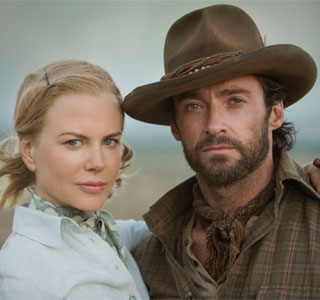Australia
by M. Faust
Years in the making and only days off the editing table, Baz Luhrmann’s Australia is an epic about his native land that runs for two hours and 40 minutes, not counting eight minutes of end credits (which you’ll have to sit through if for some reason you want to hear the overproduced Elton John song buried there).

Some of you may blanch at the thought of a movie that, once you throw in a few trailers at the beginning, will have you sitting in the dark for nigh onto three hours. I’ve never understood that attitude. Given what you pay for movie tickets these days, why wouldn’t you want to get the maximum value for your buck? The mere fact that you’re going to see it means you’re expecting it to be good, and only bad movies are ever too long—good ones are never long enough.
Australia certainly isn’t long enough, but for a different reason. Luhrmann has enough material here for three separate films, each with a storyline that doesn’t initially seem congruent with the others. Aided by scripters Ronald Harwood (The Pianist), Stuart Beattie (Pirates of the Caribbean), and Australian novelist Richard Flanagan, he’s able to meld these threads together. But each seems truncated, as if we were watching an abbreviated version of a made for television miniseries.
The story starts in 1939, as aristocratic Lady Sarah Ashley (Nicole Kidman) leaves England to retrieve her husband from Faraway Downs, the cattle ranch he has taken over in Australia. Arriving shortly after he has been murdered by a competitor, she tries to save her inheritance by driving the cattle hundreds of miles across difficult territory with the aid of a local drover (Hugh Jackman).
The second thread involves the attack on the port city of Darwin by the Japanese air fleet, shortly after Pearl Harbor. Not well known outside of Australia, the attack used more planes and bombs, and killed 238 people.
Woven through these are the Australian government’s misguided policy toward mixed race children of white and Aboriginal parents. Worried about racial purity, the government took such “half-caste” children away from their parents (white or native) to be raised in mission schools and trained to be servants. It was a terribly shameful chapter in the country’s history that went on until the mid-1970s (and was the subject of the heartbreaking film Rabbit Proof Fence).
Faraway Downs has one of these in Nullah, who is the narrator of the film and surrogate son to Lady Sarah and the otherwise-unnamed drover. (Did I mention that they become an item? Did I really need to?) As played by a young actor named Brandon Walters, Nullah is as strong an argument for a world-wide melting pot as you ever could hope to find.
This is a lot of material for one movie, and while we want an epic to be as filling as a Thanksgiving dinner, Australia needed a little more cooking time. More than once I was taken aback when the movie skipped past an expected scene, like when the cattle drive needs to detour into the desert in order to get to water or when the character who looked to be the main villain is dispatched in a montage. The Darwin section plays more like a sequel than a continuation of the ranching scenes, and the subplot in which Nullah is taken away to a mission school doesn’t have nearly the resonance it should, at least not to non-Australian audiences unfamiliar with the treatment of these kids.
All of which is not to say that Australia is a bad film. It’s an unapologetically traditional movie, surprisingly so from the maker of Moulin Rouge. In fact, moviegoers who hated Luhrmann’s previous films are more likely to enjoy this than his regular fans. There are times when his use of shallow focus to separate characters from the background makes this look like a movie from the 1940s (though he also provides plenty of spectacular footage of the Australian landscape).
It’s certainly old-fashioned in its use of its stars. Kidman’s initial aristocratic priggishness isn’t terribly persuasive, but it’s only there as a stance from which she can be eroticized (within PG-13 limitations, of course) by this barely civilized continent. Bearded and scowling, Jackman looks for all the world like the Clint Eastwood of A Fistful of Dollars, and strips down to wash off the trail dirt in a scene that can only be explained as his audition for People magazine’s “Sexiest Man in the World” issue.
You have to give Luhrmann credit for resisting efforts to tailor his movie to international audiences. It’s not that the cast features practically every actor of note in the Australian film industry—along with Kidman and Jackman, there are Bryan Brown, David Wenham, Jack Thompson, David Gulpilil, and Bruce Spence—but that there’s not a single American name in sight. For better or worse, it’s as Ozzie as the logo that opens it, which features an emu and a kangaroo.
Check out more movie trailers & local video on AVTV!
blog comments powered by Disqus
|
Issue Navigation> Issue Index > v7n48: Retreat! (11/27/08) > Film Reviews > Australia This Week's Issue • Artvoice Daily • Artvoice TV • Events Calendar • Classifieds |









 Current Issue
Current Issue